



© 2004-2022 Thomas Jäkel
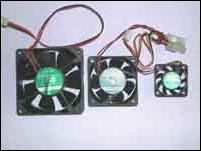
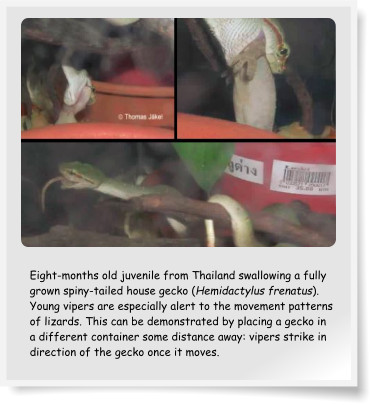
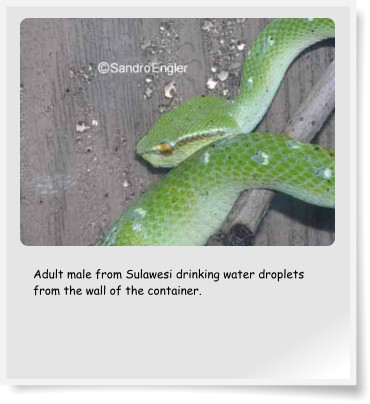
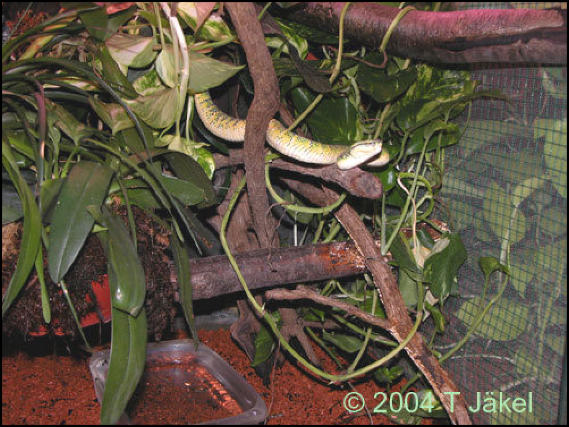
Above:
Portrait
of
a
cage
suitable
for
large
temple
vipers
(terrarium
of
Ewald
Toenjes).
Note
the
dense
vegetation,
the
horizontically
arranged
branches
and
that
the
floor
is
covered
with
porous
clay
balls,
which
aid
in
maintaining
high
humidity.
Containers
like
this
one
require
additional
ventilation
by
small
fans,
as
air-flow
may
become
stagnant
under
plants
or
in
other
places
providing
suitable
conditions
for
pathogenic
bacteria
to
grow.
Needless
to
say
that
regular
removal
of
decaying
plant
matter
or
snakes'
feces
is
mandatory.
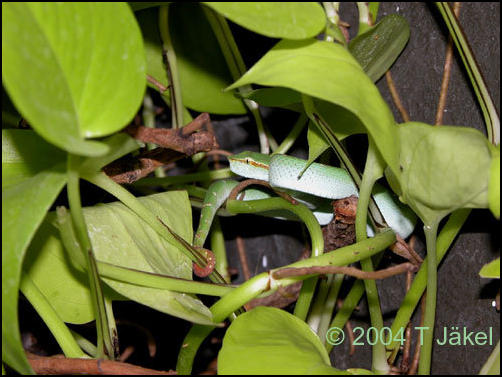
Above:
Dense
vegetation
that
prevents
visual
contact
among
vipers
is
helpful
to
avoid stress induced by territorial behaviour.
Laboratory-bred mice or rats are the most convenient food items for feeding snakes. Most Wagler's
vipers accept rodents right away, or can be adapted to that diet. However, some adult male and
juvenile temple vipers notoriously reject rodents. If there are no lizards available, it must be clear
that some specimens need regular forced or assisted-feeding sessions. More on that in the
'breeding' chapter. This is the point, where this poisonous snake cannot be recommended to an
inexperienced person. Although lizards or frogs may be highly accepted by the snakes, wild-caught
prey poses a health threat as it could contain pathogens. I have experienced losses due to
infections acquired through geckos.
Adult males can be tricked to accept food items by provoking a bite. Warm up a dead mouse or rat
in front of a light source, and tip the snake with this on the tail. After some time, the viper will strike,
eventually keeping hold of the prey.
Checking this out requires time.
Patience is necessary. Needless to say
that these activities are only successful
during night time, or shortly after the
light has been switched off.
Healthy adult females are usually good
rodent eaters, but tend to become
overfed. Offering a mouse or small rat
every 3 or 4 weeks (or even longer
periods) is sufficient, given the highly
sedentary lifestyle of this snake. Birds
are also well accepted, and probably
reflect the natural diet of adult
females. Females can keep feces for
months (up tp 6 months may be
possible). Then, certain measures
should be taken to stimulate
defecation. Placing the snake into a
shallow water bath for some hours may help (aqua-terraria provide this opportunity every day). If
the snake still refuses to release feces, a gentle massage towards the cloaca should do the job.
The size of the container also influences the constipation problem: Wagleris should be given ample
space, meaning that once these rarely moving snakes actually become active they like to wander
around which often triggers defecation. Small containers (e.g. equal to or shorter than the snake's
head-to-tail length) clearly limit this ability. Males behave differently, as they usually defecate after
each meal.
Due to the wide distribution of this species, populations differ considerably with regard to food
preference and general behavior (because they probably represent different species; see chapter
'Taxonomy'). However, the two main climatic requirements mentioned above usually apply to all of
them. Philippine (Luzon) male and female vipers and juveniles readily accept mice and are quite
agressive during day and night. This is also true for animals from some locations in Borneo. Vipers
from the Malayan peninsular, in contrast, are usually quite docile (at daylight only!) and reflect much
of the 'typical Wagleri' known by the reptile hobbyist community. Sumatran populations are similar
in coloration to the Malayan form, but are usually more aggressive than the latter. Anyhow, when
the right prey is in sight and climatic conditions are favourable, any Wagler's viper stikes with
enormous speed and power.
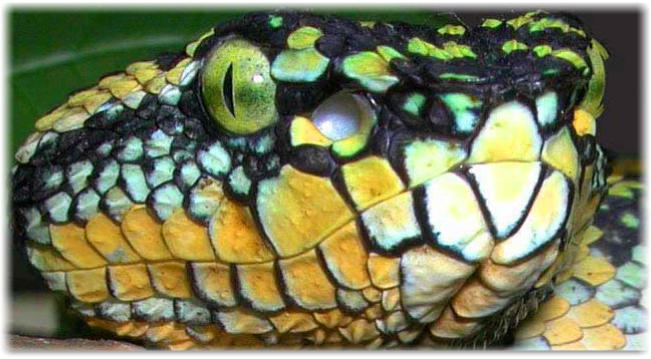
Wagler’s Viper Site - Husbandry
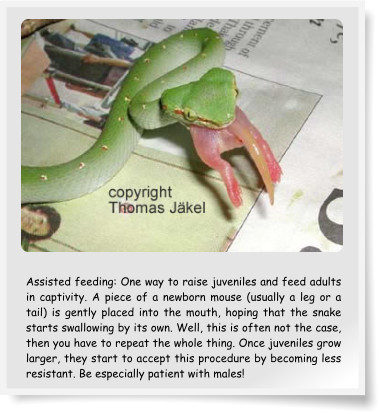


© 2004-2021 Thomas Jäkel

Wagler’s Viper in Captivity
There are various attributes and statements that have been used to decribe Wagler's viper in captivity: docile snake, lethargic, beautiful but difficult to keep and feed, problems with lung infection, constipation etc. Wether these potential problems may arise or not, depends on how one generally approaches husbandry of this snake. Wagler’s Viper, with exception of adult females, is primarily a lizard eater. Those of you who can experience the speed with which this viper strikes at geckos (even following the prey if necessary) will learn to know its true nature. Clearly, ecological pecularities like preference for certain food items and other things have to be considered right from the beginning, if one wishes to be successful in keeping this snake healthy. Wagler's viper reacts very sensitive to alterations of climatic conditions. However, once these are taken care of properly, it can be kept healthy for many years. Then, this species may also breed regularly. Let's go right into the matter and name the three most important points which have been cited by others, but are too often ignored by snake keepers: - Tropidolaemus wagleri requires high humidity, 80% and up. Of course, not constant rain showers or wet resting places. - This snake needs to drink water regularly. Drinking here means not just some drops at the wall of the container, but providing water as long as the animal wants to drink (by spraying droplets on the body and let the snake drink it, or applying water directly to the mouth using a pipette). Offering water in a shallow bowl may be accepted by some animals, but most don't. Therefore, it is necessary to spend as much time as possible watering the snakes. This point is neglected by many keepers. Not doing so will result in digestive problems, ultimately clogging the intestine by dehydrated and hardened, undigested matter. In the worst case, the intestinal tissue can stick to the fecal pellet. Wagler's viper needs a lot of water to discharge uric acid effectively. It is a myth that Wagler's viper cannot digest hairy prey: they just need enough water to digest it. - Lots of fresh air, for instance by means of small electric fans (like the ones used to cool computers) installed in a large container, or by continuous operation of an air-pump (as used for the aquarium) in a small container. Electric fans should be time-controlled running for a few minutes each hour. Negligence of these facts results, sooner or later, to lung infections which are often due to the common soil bacterium Pseudomonas aeruginosa. As we discuss in the 'health' section, this still needs not be of much concern as it can be cured by putting an affected animal under the right environmental conditions. When bacteria reach other parts of the body, however, antibiotic treatment may be inevitable to save the animal. As T. wagleri is a lowland tropical rainforest inhabitant, temperatures of 28-32° C during the day are fine, and dropping down to 24-25° C at night (although this is by no means a rule in all habitats in the wild). However, keeping the snake constantly at 23-24°C, which has been recommended already, does certainly not reflect the natural situation. This may be suitable for animals from higher altitudes, however, then one should know the snake's exact geographic origin. Trying to 'adapt' Wagler's vipers to any given condition is not a successful approach. Rather doing the opposite, fitting conditions to the particluar snake by especially maintaining a suitable climate (the two basic points) is of prime importance. This includes constant checks on ventilation (and readiness to make immediate alterations if necessary) and daily observation of the behavior of the animal. A healthy Wagleri is usually recognized by an S-shaped resting position, being highly alert during night to movements or changes in temperature which are detected with its heat sensors hidden in the loreal pits. Spraying the (preferably dense) vegetation and the snake itself with water is highly recommended. The best time to do that is in the late afternoon or evening, shortly before or after the light has been switched off. Wagler's pit vipers do not like to become confronted with a beam of fine water droplets (then they shake their heads, a sign of distress). They prefer larger drops of water like in nature. Humidity can be kept high by using appropriate filling materials for the bottom of a container that retain water; e.g. porous clay or coconut shell. Rainfall stimulates the animals to drink. They turn their heads towards the body, and start drinking water droplets attached to it. Do not expect a Wagleri to move to and drink from a small container filled with water nearby, they usually don't do that. It is advisable to replenish water as long as the animal is drinking. This may be a time- consuming activity. Be prepared of doing that for hours, depending on the size of your snake collection. How often a Wagleri drinks depends on seasonal factors, its health status, and whether or not is has to digest prey. Clearly, the snakes need more water when digesting prey and when they are ill. A healthy Wagleri may not drink much for several weeks, just to change that habit instantly, requiring large amounts of water. It is a convenient (for the snake keeper) and a healthy (for the snake) approach to keep a Wagleri in an aqua-terrarium. The water level should be quite low, about 5-10 cm, and branches of wood or stones should provide easily accessible resting sites. Water temperatures of about 25-30 °C are fine, and a strong air-pump should agitate the water providing fresh air. A large water body keeps humidity at the required high level (controlled by water temperature and ventilation), reducing the need of extensive spraying. This type of container is also advantageous because the snakes can take a bath which Wagleris actually do occasionally, especially after shedding skin. Once a snake enters the water it usually starts defecating. Wagleris that are kept under such conditions do not show constipation. This setup also reflects the natural situation, as the snake is often found close to streams or in mangroves. Of course, such a setting requires an easily accessible water container, as regular changes of water are necessary.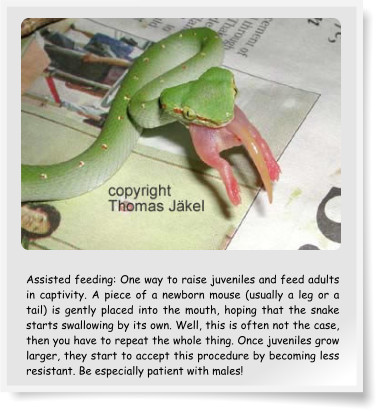
Laboratory-bred mice or rats are the most
convenient food items for feeding snakes. Most
Wagler's vipers accept rodents right away, or can
be adapted to that diet. However, some adult
male and juvenile temple vipers notoriously
reject rodents. If there are no lizards available, it
must be clear that some specimens need regular
forced or assisted-feeding sessions. More on that
in the 'breeding' chapter. This is the point, where
this poisonous snake cannot be recommended to
an inexperienced person. Although lizards or
frogs may be highly accepted by the snakes, wild-
caught prey poses a health threat as it could
contain pathogens. I have experienced losses due
to infections acquired through geckos.
Adult males can be tricked to accept food items
by provoking a bite. Warm up a dead mouse or
rat in front of a light source, and tip the snake
with this on the tail. After some time, the viper
will strike, eventually keeping hold of the prey.
Checking this out requires time. Patience is
necessary. Needless to say that these activities
are only successful during night time, or shortly
after the light has been switched off.
Healthy adult females are usually good rodent
eaters, but tend to become overfed. Offering a
mouse or small rat every 3 or 4 weeks (or even
longer periods) is sufficient, given the highly
sedentary lifestyle of this snake. Birds are also
well accepted, and probably reflect the natural
diet of adult females. Females can keep feces for
months (up tp 6 months may be possible). Then,
certain measures should be taken to stimulate
defecation. Placing the snake into a shallow water
bath for some hours may help (aqua-terraria
provide this opportunity every day). If the snake
still refuses to release feces, a gentle massage
towards the cloaca should do the job.
The size of the container also influences the
constipation problem: Wagleris should be given
ample space, meaning that once these rarely
moving snakes actually become active they like to
wander around which often triggers defecation.
Small containers (e.g. equal to or shorter than
the snake's head-to-tail length) clearly limit this
ability. Males behave differently, as they usually
defecate after each meal.
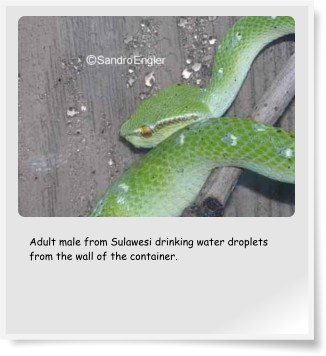


- Home
- Wagler's Viper Site (WVS)
- General Husbandry - WVS
- Breeding - WVS
- Health Problems - WVS
- Taxonomy and Phylogenetics - WVS
- Biology - WVS
- Geographic Variability - WVS
- How Females Change - WVS
- Venom - WVS
- Image Map - WVS
- Special: T. laticinctus - WVS
- Special: North Sumatra - WVS
- Special: Video on Mating - WVS
- Special: North Sulawesi - VVS
- Biological Rodent Control - BRC
- Rodent Management Laos - BRC
- Gallery
- Contact









